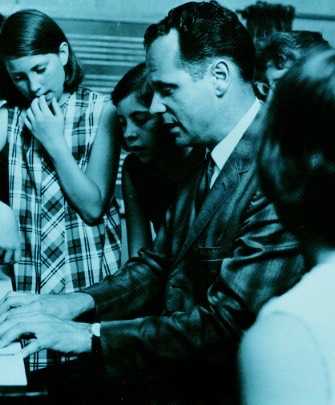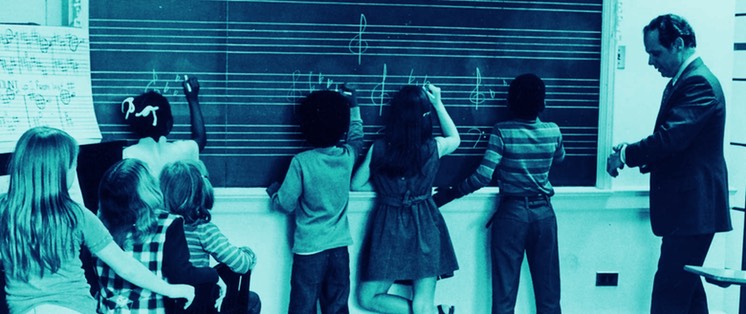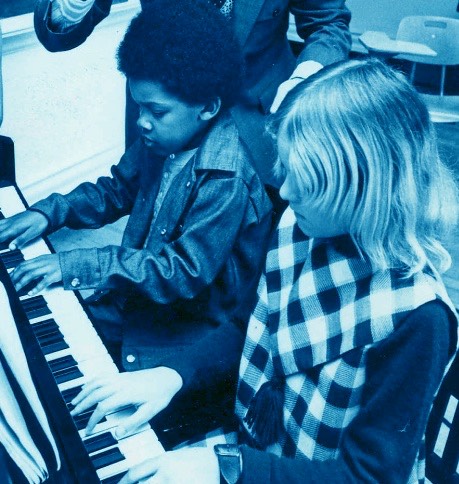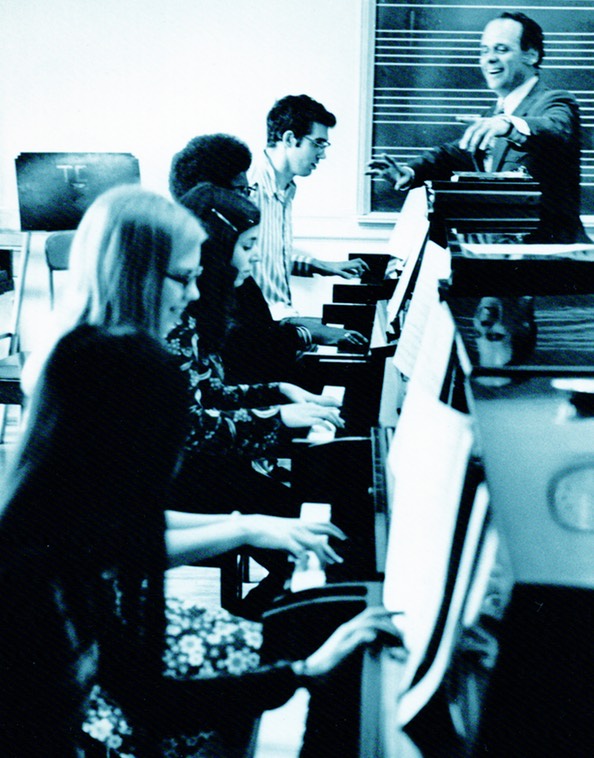TRADITIONAL “PRIVATE” LESSONS AS A CHILD

As a youngster I had the traditional "private" or individual piano lessons which essentially meant memorizing pieces and developing technical expertise. In my piano lessons we
always seemed to run out of time so that we never did quite get to study the "music fundamentals." It seemed like a good idea but there was no time in the regular lesson period. But then, assuming that I wanted to be a professional musician who would pursue my musical training further, I was told that I would get all of this in college where theory, ear-training, dictation, sight-reading, keyboard harmony, etc. were required courses.
Later, whn I entered the Juilliard School of Music, that is precisely what happened. I had classes in theory, ear-training, sight-reading, dictation and keyboard harmony in addition to my piano instructions with Josef and Rosina Lhevinne, and the mandatory piano master class each Monday evening. During the Monday evening class, various pupils played newly-learned repertoire for each other while both Josef and Rosina made comments and/or played the pieces.
INFORMAL GROUP LESSONS WITH JOSEF AND ROSINA LHEVINNE
Although our private lessons were ostensibly one student at a time, as I look back I realize that there frequently was a second student at my lesson or that I was required to attend someone else's lesson. One reason for the "other person" was that we were constantly working on concerti which needed a second piano part. Sometimes, however, I was told to appear at someone else's lesson because he or she was working on a composition that I would be learning in the near future. Unfortunately, this seemed more of an inconvenience in my already overcrowded schedule than something to which I should look forward to, but I did it since I had no choice in the matter.
TEACHING AT JUILLIARD - GROUP AND INDIVIDUAL
Upon graduation from Juilliard I had the good fortune of being asked to join that faculty to teach both piano and keyboard subjects. The piano instruction I gave was the usual individual lesson, while the keyboard harmony was in groups of approximately eight students each. It seemed quite logical to teach in this manner, since that was the way I had learned. It was not long, however, before I began to feel that I was repeating myself unnecessarily in the piano lessons. Frequently, I despaired that the student I was teaching at 5 o'clock was not benefiting from the exact same thing that had been discussed with another student at 3 o'clock.
DR. RAYMOND BURROWS - "CLASS PIANO" METHOD
About this time, I heard of the work in "class piano” of Dr. Raymond Burrows, Professor of Music Education at Teachers College, Columbia University. Since he was literally "across the street” from Juilliard, I decided to pay him a visit to see what it was all about. He invited me to observe his piano classes.
To telescope several months' events, what I saw in those "class piano" classes made me realize that certain aspects of piano instruction could be done better in groups than with one student at a time. Specifically, analyzing repertoire, developing sight-reading and transposing skills, and dealing effectively with one's fears about playing in front of others were much more efficiently handled in class instruction than in the private lesson.
PRIVATE LESSONS FOR REPERTOIRE, CLASS LESSONS FOR MUSIC FUNDAMENTALS?
But I still preferred the individual or private lesson when it came to "polishing" repertoire. I wasn't sure just why I preferred it—perhaps it was just more comfortable for me that way. Soon, I was working on a masters degree at Teachers College and, at the same time, establishing a studio in Scarsdale, New York. The studio was near several schools and there was an abundance of young students who were willing, if not always eager, to begin piano lessons. As a result of my training at Juilliard and Teachers College, I was firmly convinced that all students should receive a solid background in music fundamentals. Therefore, piano lessons for all ages involved one theory class and one private piano lesson per week.
I noticed quickly that my young students really enjoyed their theory or "musicianship" class, which was in sharp contrast to my college experience where many students felt the class was a bore, a waste of time, and "who cares about parallel fifths anyway?" My youngsters seemed eager to come to the studio just for the class, and there was always a certain sense of excitement and special interest in what was happening.
My students generally did well in the private lessons but there were times when they really didn't like the piece they were learning, or when there seemed to be too many excuses for why there hadn't been enough time to practice that week. On occasions, I suspected a less prepared student would rather talk through a lesson period than demonstrate at the piano what he or she had accomplished since the previous lesson. In contrast, there was little "chatting" in the musicianship class. But I still clung to the private lesson each week as it seemed the only way to polish the pieces as part of the fine tuning for performance.
CAR POOL CREATES NEW PERSPECTIVE!

It took something totally unrelated to music learning to give me a new perspective on this area of my teaching. It began one afternoon when a mother stopped at the studio door to ask if her daughter could stay through the next lesson, so that both students could ride home together with the second mother. This presented no problem to me, and we proceeded though the first student's lesson. As we began the second lesson, the first student seemed curious about one of the pieces on which we were working. Instead of sitting in the waiting area and doing homework, she got up and approached the piano several different times. When I asked her if she would like to join us, she was delighted and watched closely as we went through the remaining pieces.
I gave this no further thought until the mother made the same request two or three weeks later. Student "A," at the end of her lesson, was obviously quite eager to see what was happening with Student "B," and, conversely, I detected that Student "B" was equally eager to have a companion. However, we had little interaction between students during this second lesson because I still subconsciously considered this the private lesson time of Student "B." It did strike me that both students seemed more alert, were trying harder, and were eager to help each other.
The following week we discussed the possibility of letting these two girls come and go together to save an extra trip. When I talked with the mother of the second student, she had no objections to her daughter coming earlier so they could spend the combined lesson time together. Now I began to see this situation in a different light, and to realize that there were some important implications for all of the students in my studio.

PAIRED LESSONS - IMPROVED ATTITUDES
Perhaps the most striking change I observed was the improved attitudes of both students. There were fewer excuses about conflicts with practice, and during the lesson, both students were concentrating more and trying harder. If one's attention slipped a bit, the activity and success of the other student seemed to get her back on the track almost immediately.
ADVANTAGES IN STUDYING REPERTOIRE WITH A PARTNER
Certain advantages in learning repertoire (both solo and duet) in the paired lesson, or "dyad," were apparent. A "built in" duet team was a joy, since both partners were there each week and we did not have the frustration of needing to schedule extra sessions to get together. Gradually, I realized that even when one student had a bad week, the other would almost invariably come in well prepared. Therefore, not all was lost that week, and the momentum of learning kept us moving ahead.
Certainly there were fewer excuses; a well-prepared lesson became the rule rather than the exception. It became increasingly clear that two students studying together could absorb and learn far more than either could do alone during the week.
STUDENTS VOTE TO ADOPT DYAD & LARGE CLASS FORMAT
These two partners were so delighted with their new dyad lesson arrangement, that they began to sell it to other members of their group. This unsolicited enthusiasm prompted me to give the entire class of 10 children the option of trying the dyad (two students) plus the group class for the remainder of the year, or continuing with the individual lesson plus group class. Parent reactions ranged from a few enthusiastic acceptances to mostly guarded compliance. Since there were no hold-outs, we all agreed to give it a try.
Happily, by the last week of lessons, around June 15th, the students actually requested the continuation of the dyad plus group in the fall. Now, I had the dilemma of what to do with the rest of the studio. I finally decided that it was best to drop the individual lesson in favor of either a dyad or triad (three students) plus the group.
Almost immediately, I encountered problems which had not come up previously. These did not come from new students but rather from a few students and/or parents who were already taking lessons.
PROBLEMS
The new students and their parents were willing to accept whatever mode of instruction I, as the teacher, felt was best. On the other hand, several parents of children who had taken private lessons previously, were not too hospitable toward the concept of a dyad lesson. In fact, there were even some uncertainties in my mind, as I tried to put together the best of the traditional private lesson, with the economies of what was at that point still called "class piano."
In perspective, the term "class piano" then usually referred to piano instruction for 8 to 20 beginning or less advanced piano students who met once or twice a week as a class. All studied common repertoire, technique, sight-reading, keyboard harmony, etc. More advanced students and/or piano majors might receive instruction in smaller classes usually consisting of 4 students for two hours, or 2 students for one hour. Usually, each student had different repertoire, although some common assignments did occur.
One of my concerns was how to relate the student's theoretical studies to the learning of piano repertoire and vice versa. Repertoire seemed to be more efficiently handled with one or two students at a time; the study of harmony, ear-training, sight-reading and improvisation was better accomplished in the larger group. How could one capture the best from both large and small groups? Putting the large groups together seemed to pose no major problems but the headaches really began when I tried to match up students for dyad lessons. Invariably the two who would be best together had conflicting after-school schedules involving sports, scouts, religious instruction or some other excuse.
It was difficult to get parents to understand the importance of good dyads, not just scheduling any two students who could come at the same time. Obviously this would require compromises on several peoples' parts—the after-school sports director, the scout leader, the religious instructor, and, of course, the piano teacher. Most people seemed unaware of the critical nature of matching two students as dyads for piano lessons, since grouping in other after-school activities was less critical. After several years of struggling with dyad matching, I realized it was essential to schedule these in the late spring, not in the fall. Then, the other organizations could schedule in the time that remained. Eventually other group piano teachers in the area actually exchanged students in the interest of getting better dyads. This working together, as colleagues rather than existing as competitors, greatly benefited everyone in the community.
A real problem develops when one child moves away or discontinues taking lessons and leaves the partner behind. The latter situation may occur when, after several years of piano study, a student wants to study another instrument, or indeed decides to go it alone if sufficient expertise has been attained.
 What can the teacher do in this situation? If there is an odd number of students a triad should be considered. The dynamics of a good three-way interplay may be trickier to achieve if two students are close friends and the third considered an "outsider." The teacher can involve all three students in a solid three-way peer learning experience, however, if she or he makes students aware of this potential problem, and shows them how to avoid it.
What can the teacher do in this situation? If there is an odd number of students a triad should be considered. The dynamics of a good three-way interplay may be trickier to achieve if two students are close friends and the third considered an "outsider." The teacher can involve all three students in a solid three-way peer learning experience, however, if she or he makes students aware of this potential problem, and shows them how to avoid it.
Occasionally, there may be two students who do not function as well together as they should. Re-matching during the year can be difficult, since schedules involving other activities have already been arranged. The best policy is to inform parents at the outset, and remind them during the year that certain regroupings may become necessary, but that these would only be attempted when it would benefit the child. On the other hand, while teachers should be watchful for a possible mismatch, there are relatively few dyads or triads that could not function satisfactorily, given the proper attention, planning and time to develop.
SPECIAL POINTS TO CONSIDER
The dyad is not a panacea for solving all performance problems, just as the large group is not automatic insurance against problems in teaching music fundamentals. The following are not listed in any order of importance but just as they seem to unfold.
1. As student "A" performs, check student "B" to be sure that he or she is actively involved as a listener-critic. Above all, do not let students daydream or be inattentive.
2. Have the students identify the main points to be considered before the piece is performed. This takes only a few minutes and highlights what to look and listen for. Teachers too often "tell" their students rather than getting them to show each other.
3. Teachers should avoid answering questions too quickly thereby depriving students of opportunities to think out good, appropriate answers.
4. Since harsh criticism has a negative effect and noncommittal half-statements are of little value, help students learn how to be both positive and accurate in their criticism of self and others. Students should identify the good things in a performance as well as point out the problems. Building on good points tends to minimize the problems.
5. Do not encourage competition at the expense of positive reinforcement. Both partners should learn that their individual success and growth contributes to a better learning environment for everyone. They should get satisfaction from their partner's success.
6. Too often students will settle for less than they could and should accomplish. Both members of the dyad can have a healthy influence on the other as they both strive to realize their own individual musical potentials. They could and should have high yet realistic goals.
7. Students in private lessons frequently get bogged down trying to get a particular piece "polished." They lack the necessary critical processes which keep them from getting the highly polished product they seek. On the other hand, the good learning processes of the dyad enable students to turn out better, more polished musical products.
SOME FREQUENT MISCONCEPTIONS
1. The dyad plus large group structure is only for beginners and intermediate students. Those who show real talent should eventually have private lessons. Not so! The dyad is an efficient effective way to develop the problem-solving techniques most appropriate for any level of advancement, so that students can become more perceptive learners throughout their entire lives.
2. Students can only get the "individual attention" they need in a private lesson. Again, not so! Students need to learn how to analyze their own special problems and then how to take appropriate action. In the dyad, both students may be similarly involved so that their two heads are much better than one in isolating problems quickly, and prescribing appropriate action.
3. The notion persists that the piano teacher is the person with whom the teenager will talk over his or her personal problems of the week. Unfortunately, students resorting to this during the lesson are often trying to cover up a lack of preparation. This type of "chatting" does not fit well in the dyad lesson, since the other member probably has practiced and is not really interested in the other student's excuses. On any occasion when a student really needs to talk to the teacher, a special appointment should be made so that he or she can return later. When this procedure is followed, the teacher will usually find that talking diminishes and practice increases.

4. Perhaps as a holdover from the "class piano" approach, some teachers still believe that all students play only the same pieces at the lesson. Quite the contrary, students will have different pieces as well as a common assignment.
5. There exists a myth that it is more difficult to "fine polish" performances in a dyad than it is in individual lessons. My experience has been that there is a real incentive, on the student's part, to bring each piece in at a higher level when he or she knows it will be performed before peers. If students bring in better prepared pieces, the teacher will get to the polishing stages sooner, and have more time to fine polish. Emphasis should be on the students developing the most efficient and effective ways of interpreting the composer's symbols, and on expanding their own critical powers of musical self-evaluation. It is not just a matter of pleasing the teacher.
6. The really talented student will be held back unless he or she has a private lesson. Again, my experience has proven this to be untrue. I have had some very bright and gifted students who tended to "rest on their laurels." When a dyad with another bright student was formed, both increased performance.
When Not to Use the Dyad
Are there times when an individual lesson might be more effective than the dyad? Yes, this is possible. For example:
1. It is not practical to attempt the dyad when a student is taking a few coaching lessons in preparation for a specific performance.
2. There are situations in Special Education when therapists may prescribe a "one-to-one" learning experience. This could be due to physical or behavioral needs or it could be related to a type of therapy being used.
3. When a partner moves away, there may be a brief period in which there is no ready replacement. Until another good dyad or triad can be formed, the remaining student can proceed in individual lessons.
4. There are teachers who have only a few students and these are of such diverse ages and background that grouping is really impossible. It would not make sense to group an eight-year-old beginner with a 15--year-old advanced student. This does not mean, however, that we cannot group together students of varied ages and levels of achievement.
WAYS TO SEE THE DYAD FUNCTION BEST
1. Teachers who have never taught dyads in conjunction with the group are advised to first try with beginning students. In this way, you can grow with your students. Then, compare your group of new students with other students in your studio who have had only individual lessons. If you like the results of group and dyad teaching and make the decision to offer this type of instruction, make it the policy for all students. Otherwise, a student who momentarily encounters difficulties in the dyad because of previous problems, may opt for the individual lesson again rather than face and solve problems.
2. Schedule orientation sessions for the parents, and remember that you will be educating the entire family. Few parents have seen the dyad in operation, but if properly introduced, they will soon grasp its importance.
3. Informal recitals or "open classes" every six weeks will do much to keep parents informed and make them more supportive of your program.
DO’S AND DON’T’S ON REGROUPING DYADS
Don't hasten to regroup whenever one student seems to move ahead of the other. Ascertain if this is a normal growth cycle, or if one is really consistently capable of moving faster than the other.
Remember that students are rarely good in all aspects of their music learning, and that frequently one will excel in several areas, while the other will demonstrate superiority in other areas. If, after careful consideration, you feel that one member of the dyad is being either pressured or held back, new partners should be sought. Here are some points to consider if you decide to regroup.
1. Will different dyad combinations produce stronger pairings throughout, or will this regrouping improve one dyad at the cost of others?
2. Are you anticipating regrouping possibilities in the event several students move? This may influence what new or transfer students you accept for next fall.
3. Do your dyads generally function well together? If two students develop strong and persistent personality conflicts, regrouping is in order.
4. Conflicts in after-school scheduling can complicate forming good dyad groupings. Try to get both students and parents to see the advantages of the dyads you have proposed.
5. From a beginning group of eight or 10 students, even the most conscientious teacher might find only one or two dyads of 17-year-olds because of our transient society. In view of this, teachers should work as colleagues to plan ahead to see how they can feed students into the most effective learning groups. The long-range planning will benefit both teachers and pupils.
In conclusion, dyad or triad teaching is not a magic formula to dissolve all the problems of teachers and students. It is a valuable teaching tool that will CAN enrich and advance the learning process for everyone involved.
Give it a try--you and your students have much to gain!
Adapted and Reprinted from Keyboard Journal Volume 5 No. 1. Copyrighted.
No portion of this article may be reprinted without written permission from copyright holder
